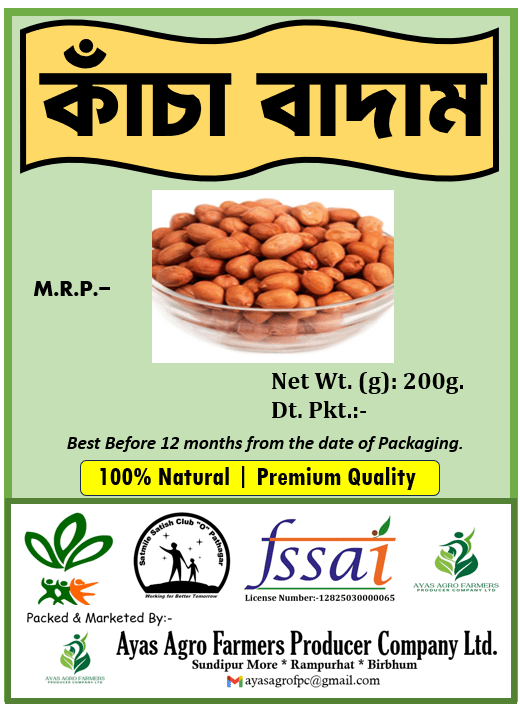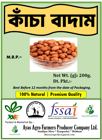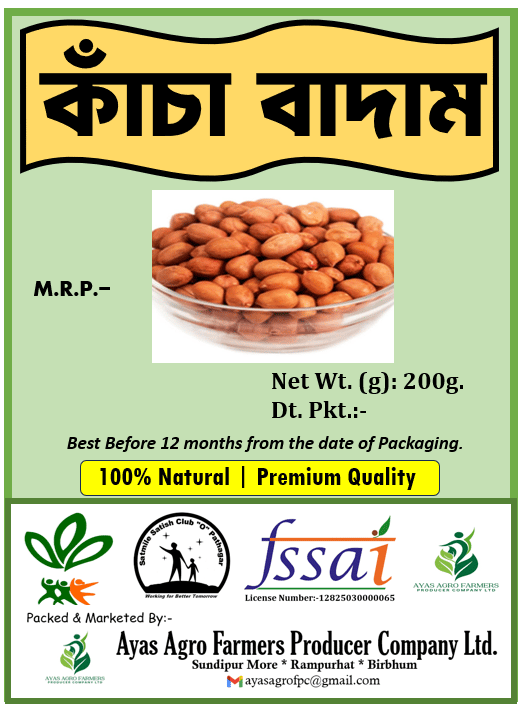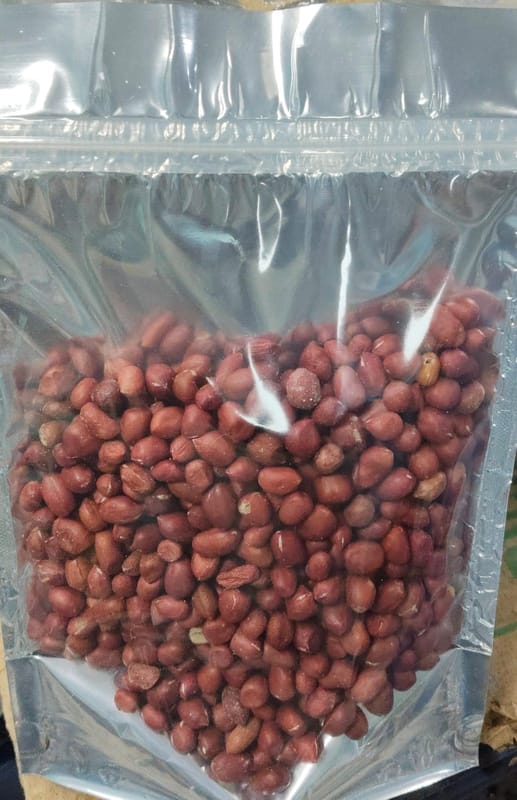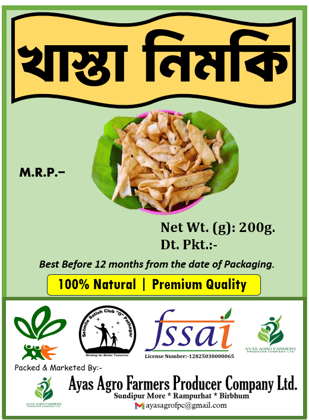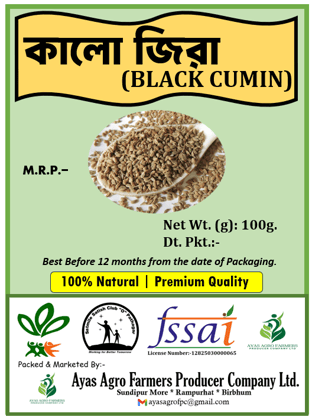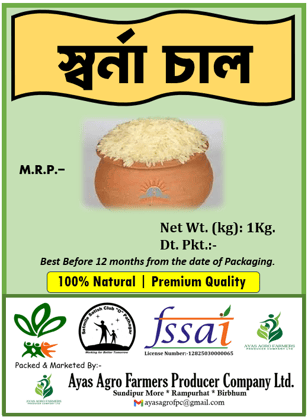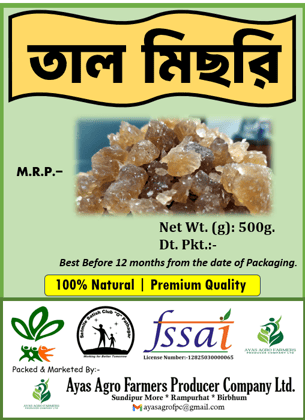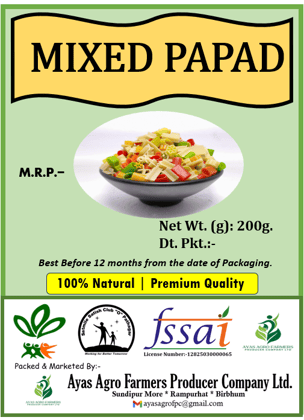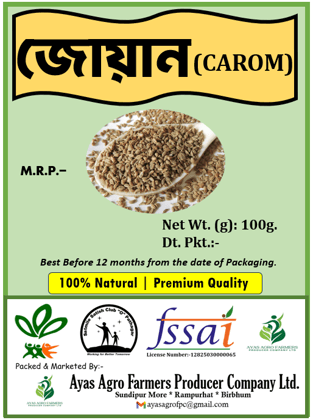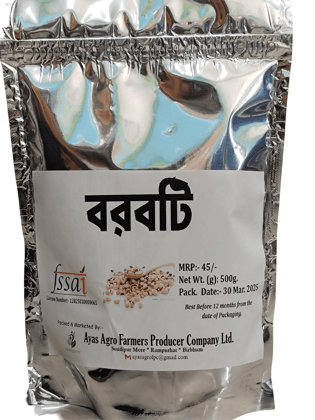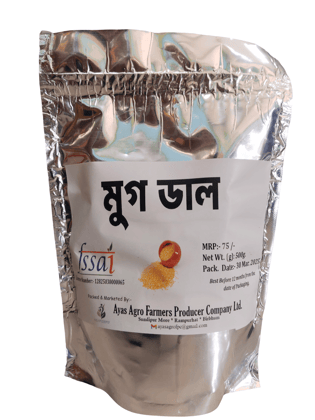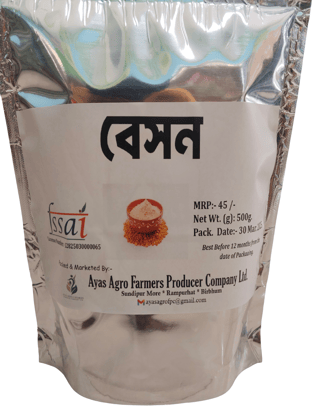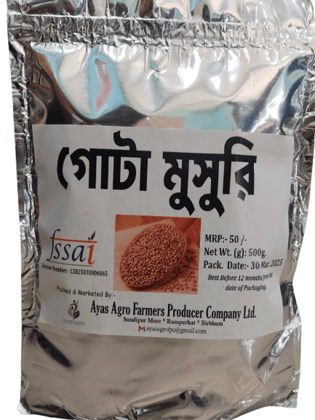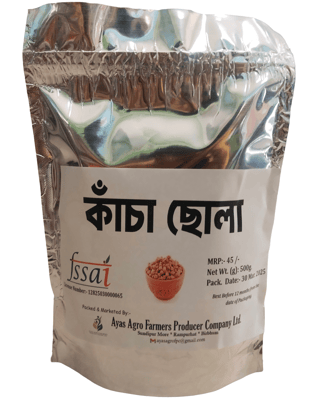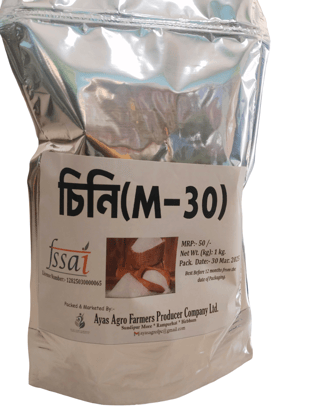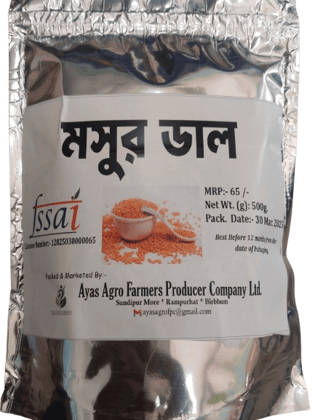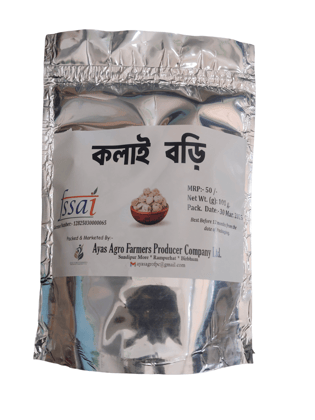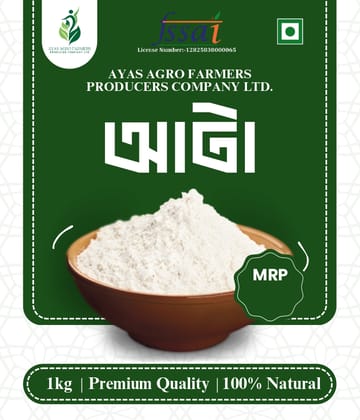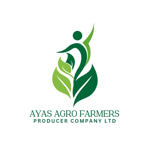"Kacha Badam" (কাঁচা বাদাম in Bengali) directly translate...
KACHA BATAM (Raw Peanuts) 200 GM
Veg
Key Attributes
| Country of origin | India |
|---|---|
| Net Quantity | 200 gram |
| Product Dimensions | 18L x 11W x 18H cm |
| Manufacturer or packer name | Ayas Agro Farmers Producer Company Limited |
"Kacha Badam" (কাঁচা বাদাম in Bengali) directly translates to "Raw Peanuts". However, the term gained immense global recognition not just as a food item, but as the title of a massively viral song that originated from West Bengal, India.
Let's break down the description of "Kacha Badam" in both its literal and cultural senses:
I. Kacha Badam (Raw Peanuts) as a Food Item:
- What it is: "Kacha Badam" refers to uncooked, unprocessed peanuts still in their reddish-brown skin, sometimes even in their shell. Peanuts (Arachis hypogaea) are a type of legume that grow underground.
- Appearance: They are typically off-white to pale beige in color after shelling, covered with a thin, reddish-brown skin. When freshly harvested, they can sometimes appear slightly greenish (often referred to as "green peanuts" or "new crop peanuts"), which are higher in moisture and have a distinct, milder flavor.
- Flavor and Texture (Raw):
- Flavor: Raw peanuts have a mild, earthy, slightly bitter taste, distinct from the nutty, roasted flavor most people associate with peanuts.
- Texture: They are firmer and crunchier than roasted peanuts, with a more "beany" texture.
- Nutritional Value (Raw Peanuts): Raw peanuts are a good source of:
- Protein: High in plant-based protein.
- Healthy Fats: Rich in monounsaturated and polyunsaturated fats, which are beneficial for heart health.
- Fiber: Good for digestion.
- Vitamins: Contain B vitamins (especially niacin, folate), and Vitamin E.
- Minerals: Provide magnesium, phosphorus, potassium, zinc, and iron.
- Antioxidants: Contain resveratrol and other antioxidants.
- Culinary Uses of Raw Peanuts:
- While often roasted, raw peanuts are used in various cuisines:
- Boiling/Steaming: Especially common in the Southern United States and parts of Asia, boiled peanuts are a popular snack.
- Curries and Stews: Used as a thickening agent or a nutty flavor base in some curries and gravies, particularly in Indian and Southeast Asian cooking.
- Chutneys and Pastes: Ground into pastes for chutneys or sauces.
- Sprouting: Raw peanuts can be sprouted and added to salads or stir-fries.
- While often roasted, raw peanuts are used in various cuisines:
II. "Kacha Badam" as a Cultural Phenomenon (The Viral Song):
The phrase "Kacha Badam" exploded into global pop culture in late 2021/early 2022 due to a viral Bengali song.
- Origin: The song was created and sung by Bhuban Badyakar, a humble peanut seller from Kuraljuri village in the Birbhum district of West Bengal. He would travel through villages on his bicycle, singing this catchy jingle to attract customers and advertise his "kacha badam" for sale, often in exchange for old trinkets, broken mobile parts, or imitation jewelry.
- Lyrics & Meaning: The lyrics of the original "Kacha Badam" song are simple and pragmatic, essentially listing what he accepts in exchange for his peanuts: "Badam badam, dada kacha badam! Amar kache naiko bubu vaja badam. Paayer tura, haater bala, thake jodi city gold er chain, diye jaben, taate shoman shoman tomra badam paben." (Roughly: "Peanuts, peanuts, brother raw peanuts! I don't have roasted peanuts, sister. If you have anklets, bangles, imitation gold chains, you can give them to me, and you'll get equal peanuts in return.")
- Viral Sensation: A bystander recorded Bhuban singing his jingle and uploaded it to YouTube. Its catchy melody, simple lyrics, and Bhuban's unique singing style quickly made it go viral. Musicians then created remixed versions, turning it into a dance trend on platforms like Instagram Reels and TikTok.
- Cultural Impact:
- Global Reach: The song transcended language barriers, inspiring dance challenges and interpretations from people across India and even internationally (e.g., in South Korea, Tanzania, France).
- Recognition for Humble Beginnings: It brought Bhuban Badyakar, a daily wage earner, into the spotlight, highlighting the power of social media to elevate ordinary voices. While there were initial challenges regarding copyright and remuneration, public outcry eventually led to him receiving some compensation and recognition.
- Celebration of Rural Life: The song offered a glimpse into rural Indian life and the ingenuity of street vendors, resonating with a wide audience.
- Internet Meme: "Kacha Badam" became a ubiquitous soundbite and meme, symbolizing a catchy, often humorous, and unexpectedly viral phenomenon.
In essence, "Kacha Badam" is both a nutritious raw food item and a powerful cultural symbol that emerged from the streets of West Bengal, showcasing how a simple jingle can capture the world's attention.
| Country of origin | India |
|---|---|
| Net Quantity | 200 gram |
| Additive info | "Kacha Badam" literally means "raw peanuts." When we talk about additives in "kacha badam," it's important to clarify the context, as raw, unprocessed peanuts typically contain **no intentional additives**. They are a natural product of the earth. However, there are a few important considerations: **1. No Intentional Additives in Pure Raw Peanuts:** * **Naturally occurring:** A genuinely "kacha badam" (raw peanut, in its most natural state, often still in its shell or just shelled) should have no added ingredients. It's simply the peanut itself. * **Contrast with Processed Peanut Products:** This is a crucial distinction. Many *processed* peanut products *do* contain additives: * **Roasted/Salted Peanuts:** Often contain added salt, and sometimes oils for roasting or flavor. * **Peanut Butter:** Frequently contains added sugar, salt, hydrogenated oils (for stability and to prevent oil separation), and emulsifiers. * **Peanut Candies/Snacks:** Will have numerous additives like sugars, artificial flavors, colors, preservatives, etc. **2. Potential Contaminants (Not "Additives" but a Key Concern):** The primary concern with raw peanuts, especially if not handled and stored properly, is the potential for **aflatoxin contamination**. * **What are Aflatoxins?** Aflatoxins are toxic compounds produced by certain molds (*Aspergillus flavus* and *Aspergillus parasiticus*) that can grow on crops like peanuts, corn, and tree nuts under warm, humid conditions. * **Why is it a concern?** Aflatoxins are potent carcinogens and can cause liver damage and other health problems if consumed in significant amounts over time. * **When does it occur?** Contamination can happen in the field before harvest (especially if there's drought or insect damage), during harvest, and crucially, during improper storage (high moisture and temperature are key factors). * **Detection:** Aflatoxins are not visible to the naked eye and don't typically alter the taste of the peanut, making them difficult for consumers to detect. However, visible mold on peanuts (gray-green or yellow-green) is a strong indicator of potential contamination. * **Mitigation:** * **Good Agricultural Practices (GAP):** Farmers employ practices to minimize mold growth. * **Good Storage Practices (GSP):** Proper drying of peanuts after harvest and storage in cool, dry, well-ventilated conditions are critical to prevent mold growth and aflatoxin production. * **Regulatory Monitoring:** In many countries, there are strict regulations and testing protocols for aflatoxin levels in peanuts and peanut products sold commercially. * **Consumer Action:** Buying raw peanuts from reputable sources, ensuring they are dry and free from any visible mold, and storing them properly (cool, dry place) can help minimize risk. **3. Minimal Processing Aids (Less Common for "Kacha Badam"):** In some very large-scale commercial processing of raw peanuts, there might be minimal processing aids, but these are generally not considered "additives" that remain in the final product in significant amounts. For example, water might be used for washing, or very mild solutions for surface cleaning before packaging. For truly raw, unprocessed peanuts sold directly to consumers, these are typically not a factor. **In summary:** If you are buying **"kacha badam" in its pure raw form** (shelled or unshelled, unroasted, unsalted), you should expect **no intentional additives**. The primary concern for raw peanuts relates to **aflatoxin contamination**, which is a naturally occurring toxin produced by mold, not an additive. Always ensure you purchase raw peanuts from trusted sources and store them correctly to minimize this risk. |
| Weight | 200 g |
| Package Dimension | 18L x 11W x 18H cm |
| Product Dimensions | 18L x 11W x 18H cm |
| Food type | veg |
| Manufacturer or packer name | Ayas Agro Farmers Producer Company Limited |
| Manufacturer or packer address | PLOT NO- 904 , KHATIYAN NO- 3227, JL NO- 079,,Rampurhat |
| Nutritional information | "Kacha Badam" refers to raw peanuts. Here's a breakdown of their nutritional information, typically for 100 grams, as raw peanuts are a very nutrient-dense food: **General Nutritional Profile (per 100 grams of Raw Peanuts):** * **Calories:** Approximately 567-587 kcal (Peanuts are calorie-dense due to their fat content). * **Protein:** Around 25.8 grams. Peanuts are an excellent source of plant-based protein, making them valuable for vegetarians and vegans. * **Fats:** Approximately 49-50 grams. * **Monounsaturated Fats:** About 24.4 grams (e.g., oleic acid) - considered heart-healthy. * **Polyunsaturated Fats:** About 15.6 grams (e.g., linoleic acid, an Omega-6 fatty acid) - also considered heart-healthy. * **Saturated Fats:** Around 6.3-7.7 grams (should be consumed in moderation). * **Carbohydrates:** Around 16.1 grams. * **Fiber:** Approximately 8.5 grams (a significant amount, contributing to digestive health and satiety). * **Sugars (natural):** Around 4.7 grams. * **Water:** Approximately 6.5%. **Vitamins:** Raw peanuts are a good source of several important vitamins, especially B vitamins and Vitamin E: * **Vitamin B3 (Niacin):** Around 12.1 mg (a very high amount, important for energy metabolism and nervous system function). * **Vitamin E (Alpha-tocopherol):** Around 8.3 mg (a powerful antioxidant). * **Folate (Vitamin B9):** Around 240 mcg (crucial for cell growth and especially important during pregnancy). * **Vitamin B1 (Thiamine):** Around 0.64 mg. * **Vitamin B6 (Pyridoxine):** Around 0.35 mg. * **Vitamin B2 (Riboflavin):** Around 0.14 mg. * **Biotin:** Peanuts are one of the richest dietary sources of biotin. **Minerals:** Peanuts are packed with various essential minerals: * **Potassium:** Around 705-750 mg (important for blood pressure regulation). * **Phosphorus:** Around 376 mg (essential for bone health, energy metabolism). * **Magnesium:** Around 168-180 mg (involved in numerous bodily functions, including muscle and nerve function, blood glucose control). * **Calcium:** Around 92 mg (for bone and teeth health). * **Iron:** Around 4.6 mg (important for red blood cell formation and preventing anemia). * **Zinc:** Around 3.3 mg (important for immune function and wound healing). * **Copper:** Around 0.23-0.27 mg (essential for red blood cell formation and iron absorption). * **Manganese:** Around 0.23 mg. * **Selenium:** Small amounts, around 12 µg. **Other Beneficial Compounds:** * **Antioxidants:** Peanuts contain various antioxidants like resveratrol (also found in red wine), p-coumaric acid, and isoflavones, which help combat oxidative stress. * **Phytosterols:** These plant compounds can help reduce cholesterol absorption. * **Arginine:** An amino acid important for healthy blood vessels. * **Phytic Acid:** While peanuts contain phytic acid (which can bind to some minerals and slightly reduce their absorption), it is also considered an antioxidant with potential health benefits. Soaking or roasting can slightly reduce phytic acid content. **Key Health Benefits Associated with Peanuts (Kacha Badam):** * **Heart Health:** The healthy fats (mono- and polyunsaturated), fiber, magnesium, and antioxidants contribute to lower LDL (bad) cholesterol, improve blood pressure, and reduce the risk of heart disease. * **Weight Management:** Despite being calorie-dense, the combination of protein, fiber, and healthy fats promotes satiety, helping to reduce overall calorie intake and support weight management. Peanuts have a low glycemic index (around 13-23). * **Blood Sugar Management:** Their low carbohydrate content, high fiber, protein, and healthy fats make them suitable for managing blood sugar levels, especially beneficial for individuals with diabetes (consumed in moderation). * **Muscle Building and Repair:** High protein content supports muscle growth and repair. * **Bone Health:** Magnesium, phosphorus, and calcium contribute to strong bones. * **Brain Health:** Niacin and other B vitamins are crucial for brain function. * **Antioxidant Power:** The rich array of antioxidants helps protect cells from damage and may reduce the risk of chronic diseases. **Important Considerations for Raw Peanuts:** * **Aflatoxin Risk:** Raw peanuts, especially if stored improperly in warm, humid conditions, can be susceptible to a mold called *Aspergillus flavus* which produces aflatoxins. Aflatoxins are carcinogenic. While regulatory bodies monitor aflatoxin levels in commercial products, buying from reputable sources and storing them properly (cool, dry, dark place) is crucial. Roasting can reduce aflatoxin levels but doesn't eliminate them entirely. * **Antinutrients:** Phytic acid, as mentioned, can slightly inhibit mineral absorption. However, the overall nutritional benefits generally outweigh this effect, especially in a balanced diet. * **Allergies:** Peanut allergy is one of the most common and potentially severe food allergies. Individuals with peanut allergies must strictly avoid all forms of peanuts. In summary, kacha badam (raw peanuts) are a highly nutritious food, offering a significant amount of protein, healthy fats, fiber, vitamins, and minerals. They are a good addition to a balanced diet, keeping the above considerations in mind. |
| Instructions | "Kacha Badam" refers to raw peanuts. Here are instructions on how to handle, prepare, and consume them, with a strong emphasis on safety due to potential concerns with raw legumes. **I. Buying Kacha Badam (Raw Peanuts)** 1. **Source:** Purchase raw peanuts from reputable vendors or stores. In Berhampore, you might find them in local markets. 2. **Appearance:** Look for plump, well-formed peanuts. Avoid any that look shriveled, discolored (beyond their natural skin color), or have any signs of mold (white, green, or black fuzzy spots). 3. **Smell:** Fresh raw peanuts have a mild, earthy scent. If they smell musty, stale, or rancid, do not buy them. 4. **In-shell vs. Shelled:** Peanuts in their shell generally have a longer shelf life and are less prone to mold growth if stored correctly. Shelled raw peanuts are more convenient but require more careful storage. **II. Storing Kacha Badam (Raw Peanuts) Safely** Proper storage is crucial to prevent spoilage and, more importantly, to minimize the risk of aflatoxin contamination (a toxic compound produced by certain molds). Aflatoxins thrive in warm, humid conditions. Given the climate in West Bengal, this is especially important. 1. **Airtight Container:** Always store raw peanuts in an airtight container (glass jar, heavy-duty plastic container, or a thick, resealable bag). This prevents moisture and air from reaching them. 2. **Cool, Dry, Dark Place:** * **Pantry/Cupboard:** For short-term storage (a few weeks), a cool, dry, dark pantry or cupboard away from direct sunlight, heat sources (like the stove or oven), and humidity is suitable. * **Refrigeration:** For longer shelf life (up to 6 months), especially for shelled raw peanuts, storing them in the refrigerator is highly recommended. This slows down oxidation and inhibits mold growth. * **Freezing:** For extended storage (up to a year or more), raw peanuts can be frozen. Place them in a freezer-safe, airtight container or bag. Freezing is the best way to preserve freshness and minimize risks for very long-term storage. 3. **Avoid Moisture:** Moisture is the biggest enemy of raw peanuts. Ensure they are completely dry before storing. If you wash them, dry them thoroughly before putting them away. 4. **Check Regularly:** Periodically inspect your stored peanuts for any signs of mold, discoloration, or an off-smell. If you find any, it's best to discard the entire batch. **III. Preparing Kacha Badam (Raw Peanuts) for Consumption** Raw peanuts have a tougher texture and a different flavor compared to roasted ones. They are typically not eaten truly "raw" in large quantities due to texture and digestibility, and also the aflatoxin concern. They are usually cooked. 1. **Washing:** Always wash raw peanuts thoroughly under cool running water before use, whether shelled or unshelled. Rub them gently to remove any dirt or debris. 2. **Soaking (Highly Recommended for Cooking/Consumption):** * **Purpose:** Soaking helps soften the peanuts, improves digestibility, and can reduce some "anti-nutrients" (like phytic acid). Some research also suggests soaking can help reduce aflatoxin levels. * **Method:** Place raw peanuts in a bowl and cover them with plenty of fresh water. Soak for at least 4 hours, or preferably overnight (8-12 hours). You can add a pinch of salt during soaking. * **After Soaking:** Drain the soaking water and rinse the peanuts again thoroughly. 3. **Cooking Methods (Most Common for Kacha Badam):** * **Boiling (Most Popular in India for Raw Peanuts):** This is perhaps the most common way to consume "kacha badam" in India, especially in the East. 1. After washing and soaking (optional but recommended), place raw peanuts (shelled or unshelled) in a large pot. 2. Cover with plenty of water. Add salt to taste (this is crucial for flavor). You can also add spices like turmeric or chili for flavor. 3. Bring to a boil, then reduce heat and simmer until soft. * **Shelled peanuts:** May take 20-40 minutes depending on their freshness and size. * **Unshelled peanuts (in pods):** Will take much longer, often 1-3 hours, as the water needs to penetrate the shell. 4. Peanuts are done when they are soft and no longer crunchy. 5. Drain and serve warm. Boiled peanuts are a popular snack, often seasoned with a sprinkle of chaat masala or black salt. * **Pressure Cooking:** This is a faster method for boiling. After washing and soaking, cook in a pressure cooker with water and salt for 4-5 whistles, then let the pressure release naturally. * **Roasting (Transforming "Kacha Badam" to "Bhaja Badam"):** While "kacha badam" is raw, they are often roasted before eating or using in dishes. 1. Dry roast in a heavy-bottomed pan over medium heat, stirring constantly, until they are aromatic and lightly browned (about 5-10 minutes). 2. Alternatively, roast in an oven at 150-175°C (300-350°F) for 15-20 minutes, stirring occasionally. 3. Let them cool. The skins will become loose and can be easily rubbed off if desired. Roasted peanuts are often called "bhaja badam" (fried/roasted peanuts). * **Frying:** Deep-frying raw peanuts results in a crispy snack, often seasoned with salt and spices. **IV. Culinary Uses of Kacha Badam (Raw Peanuts) in Bengali Cuisine (and wider Indian cuisine):** Beyond the viral song, raw peanuts are widely used in traditional cooking: 1. **Boiled Snack:** As mentioned, a very popular snack, especially during monsoon or winter evenings. 2. **Chutneys and Pastes:** Ground into a paste with chilies, garlic, and other spices to form a base for various chutneys (e.g., peanut chutney for idli/dosa). 3. **Gravies and Curries:** Raw peanuts are ground into a thick paste and added to certain vegetable curries (like in some Bengali or Odia "torkari" dishes, or Maharashtrian curries) to thicken the gravy and add a nutty flavor. 4. **Pulao and Upma:** Often added (often lightly fried or roasted first) to rice dishes like Pulao, or breakfast items like Upma or Poha (flattened rice) for crunch and flavor. 5. **Vegetable Stir-fries/Sabzis:** Used in simple Bengali vegetable preparations like "Cheena Badam Bhendi" (Okra with Peanuts) or other stir-fried vegetables to add texture and richness. 6. **Sweets:** In some traditional sweets, ground raw or lightly roasted peanuts are used, especially in laddu or barfi. 7. **Salads/Chaat:** Boiled peanuts are a key ingredient in many "chaat" (savory snacks), mixed with chopped onions, tomatoes, green chilies, and spices. By following these instructions, you can safely enjoy the nutritional benefits and versatile culinary applications of kacha badam. |
| contact details consumer care | Ayas Agro Farmers Producer Company Limited, [email protected] |
